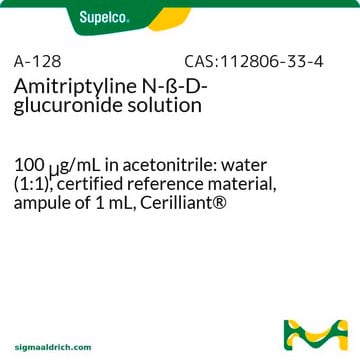About This Item
Recommended Products
Assay
≥98% (TLC)
form
powder
color
white to off-white
solubility
H2O: soluble
ethanol: soluble
originator
Bristol-Myers Squibb
storage temp.
2-8°C
SMILES string
Cl[H].CN(C)CC\C=C1\c2ccccc2CCc3ccccc13
InChI
1S/C20H23N.ClH/c1-21(2)15-7-12-20-18-10-5-3-8-16(18)13-14-17-9-4-6-11-19(17)20;/h3-6,8-12H,7,13-15H2,1-2H3;1H
InChI key
KFYRPLNVJVHZGT-UHFFFAOYSA-N
Gene Information
human ... CHRM1(1128) , CHRM2(1129) , CHRM3(1131) , CHRM4(1132) , CHRM5(1133) , SLC6A2(6530) , SLC6A4(6532)
Looking for similar products? Visit Product Comparison Guide
Application
- as an antidepressant to study its effects on social behavior and memory in transgenic for acid sphingomyelinase (t-ASM) mice
- as a tricyclic antidepressant to analyze its effects on glucocorticoid receptor function in whole human blood
- as an anti-depressant to study its effects on scratching and locomotion behavior in chloroquine-induced mouse
Biochem/physiol Actions
Features and Benefits
related product
Signal Word
Danger
Hazard Statements
Precautionary Statements
Hazard Classifications
Acute Tox. 3 Oral - Aquatic Acute 1 - Aquatic Chronic 1 - Eye Irrit. 2 - Repr. 2
Storage Class Code
6.1C - Combustible acute toxic Cat.3 / toxic compounds or compounds which causing chronic effects
WGK
WGK 3
Flash Point(F)
Not applicable
Flash Point(C)
Not applicable
Personal Protective Equipment
Certificates of Analysis (COA)
Search for Certificates of Analysis (COA) by entering the products Lot/Batch Number. Lot and Batch Numbers can be found on a product’s label following the words ‘Lot’ or ‘Batch’.
Already Own This Product?
Find documentation for the products that you have recently purchased in the Document Library.
Customers Also Viewed
Our team of scientists has experience in all areas of research including Life Science, Material Science, Chemical Synthesis, Chromatography, Analytical and many others.
Contact Technical Service















